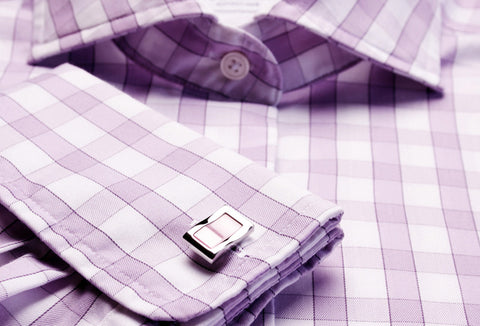Guide to Dress Shirt Weaves
Posted on 08 May 2019 | Anil Panjabi |

What’s In A Weave?
The weave is the way in which the threads of cotton (called warp and weft) are actually put together to make a fabric. The weave not only affects the way a shirt looks and feels, but also how warm the fabric will be, the way it drapes, how easy it is to iron, and sometimes, where and when it should be worn.
Thread Count
A higher thread count generally means a smoother, silkier, more expensive fabric. Like suits, the thread count is referenced with a number such as 50s, 80s, 100s, 120s, 140s, 170s and so on, up to 330s. The number refers to the yarn size, but generally a thread count above 100 will imply a 2-ply fabric.
Two Ply vs. Single Ply
Though there are some exceptions where very fine single ply yarns are used, the higher number thread counts will be comprised of two yarns twisted together. For example, 120’s thread count means that two 60’s yarns are twisted together. This fabric will be more durable than a 60’s single ply, but it won’t always be smoother. 140’s thread counts are typically two 70’s yarns twisted together. And so on.
Thread count and the ply are good indicators of shirt quality. But remember, like most craftsmanship, the mill or manufacturer and quality of ingredients (namely, cotton) have a big impact on just how luxurious the fabric, and therefore, the shirt is.
Below is your gentlemen’s guide to dress shirt weaves, as well as how and when to wear them.
Major Weave Types
Poplin

Poplin (aka broadcloth) is a cotton weave made by closely-woven threads that form a criss-cross pattern. Poplin, despite its strength, is thin, lightweight and cool, marked by a smooth finish. It makes for a great summer work shirt as it has very little sheen, which makes it nice and professional. And they’re great for a little texture too. For work, a poplin shirt is ideal as an under shirt with a smart two-piece suit, no sweat. But beware, their thin weave means white varieties can be a touch transparent.
Twill

Twill is a durable cotton fabric that has a softer feel than poplin and is slightly more sheeny. Twill fabrics weave twin horizontal threads under and over vertical threads to create a diagonal pattern.This creates interesting ‘patterns’ in the shirt such as herringbone, houndstooth or diagonal rib print (we’ll elaborate later on).
Overall, twill is soft and thick, crease-resistant and iron-proof. It drapes well, so it’s the perfect get-things-done work shirt, but with a smart finish.
Oxford

The oxford cotton fabric is known as a basket weave where multiple weft threads are crossed over an equal number of warp threads. Usually, one single-colour thread it crossed with white to give the oxford its signature checkerboard appearance.
It’s a versatile fabric that can be worn off or on-duty but is most popular in casual shirts; a button-down with no tie and jeans on the weekend. However, the shirt can be worn to the office if the cut and finish are professional. Or for a more relaxed business environment. And its thickness makes it perfect to wear on cooler days.
End-on-End

End-on-end shirt fabrics are made with a gently textured weave comprised of two or more colours resulting in a dual-tone finish. The double colour isn’t evident, looking more like a unified colour from afar. But the detail is in the close-up, where a mini-pattern can be seen for a unique finish.
End-on-end shirts are also lightweight and crisp to the hand, so they’re perfect for warmer days – worn solo, or under a light cotton suit. They’re a superb weekend shirt.
Pinpoint

Pinpoint has the same weave as the oxford but uses much a finer yarn and tighter weave. In terms of formality, pinpoint sits nicely between the casual oxford cloth and the classy poplin or twill.
They are thick and durable which can take away from their elegance. So, these shirts are perfect everyday work tops, but not ideal for special events.
Dobby

The dobby is considered a posh because its weave is much like jacquard; a unique geometric pattern that look and feels raised touch. A special loom raises and lowers the warp threads individually, allowing the weaver to create the dobby’s special patterns.
The best part? Not all dobby fabrics look the same, coming in a variety of patterns, colours, weights and hand feels to meet your style and dress code needs.
Herringbone

Herringbone shirts are recognised for their resemblance to the v-shape bones of the herring fish. The fabric is textured and is essentially a twill that is mirrored when woven to create the sort of chevron pattern.
Herringbone weaves tend to be slightly heavier in weight, and are more often found in seasonal shirting fabrics for cold weather. Add under a tweed jacket for a play on texture and apply a silk-knit tie. There are so many contrast capabilities with Herringbone. Go wild.
What’s your go-to dress shirt fabric?
